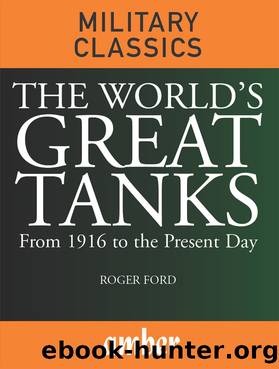The World's Great Tanks by Roger Ford

Author:Roger Ford [Ford, Roger]
Language: eng
Format: epub
Tags: Nonfiction, Religion & Spirituality, Philosophy, Religious
ISBN: 9781438449593
Publisher: State University of New York Press
Published: 2013-12-20T05:00:00+00:00
CHAPTER 4
TANKS IN
TRANSITION,
FROM POTSDAM
TO VIETNAM
The tankâs achievements during World War II ensured armourâs role in future strategic plans. The conflicts which spanned the subsequent Cold War period, plus advances in technology, ensured that the tank became one of the most decisive weapons on the battlefield.
One of the immediate results of World War IIâs coming to a close, halfway through 1945, was the downsizing of the western Alliesâ armies and the consequent withdrawal, either into storage or for disposal, of huge numbers of vehicles and weapons. Some of what remained of the weapons and equipment of the defeated German Army and the Waffen-SS went for scrap, but some was appropriated by the Allies (particularly France), and some found its way into the âsecond userâ market. Redundant Soviet equipment, what there was of it, went to equip the USSRâs client states. All this was to be expected. The same armies had, by and large, gone through the same process a quarter of a century before, but there was one big difference between the circumstances in 1945 and those of 1919. This time, there was to be no reconstitution of small independent states on the dissolution of powerful empires. Instead, exactly the reverse was to take place, as the Red Army, far from marching out of the countries it had overrun in its pursuit of the Nazis, dug itself in to stay. Winston Churchill warned of Soviet expansionism in a speech he made in Fulton, Missouri, on 5 March 1946, in which he said; âFrom Stettin in the Baltic to Trieste in the Adriatic, an iron curtain has descended across the continent [of Europel.â The western Alliesâ response to the Soviets was to set up the North Atlantic Treaty Organisation (NATO) in 1949, with the United States in a pre-eminent role. The âCold Warâ that ensued was to last for some 40 years and ensured that progress in weapons technology and in the development of new ways and means of waging war hardly slowed at all.
AGEING AMERICANS
Had it come to immediate all-out war between NATO and the Warsaw Pact countries, as the eastern bloc became known, there is little doubt who would have won, for, to misquote Bellocâs paen to an earlier weapon that changed the world, âWhatever happens, we have got/The atom bomb, and they have notâ; in other words, NATO had nuclear weapons, the Russians did not. However, that state of affairs was not to last, and once parity had been reached at the top of the weapons tree, a struggle began for supremacy lower down. And nowhere was this battle for the upper hand more bitterly fought than in the area of tanks. The vast majority of the tanks in US Army service at the warâs end were M4 Shermans of one variety or another. The Sherman was a tank designed in 1940 according to principles established during the previous decade, and it was very clearly obsolescent by this time and badly in need of replacement. In the short term,
Download
This site does not store any files on its server. We only index and link to content provided by other sites. Please contact the content providers to delete copyright contents if any and email us, we'll remove relevant links or contents immediately.
| Biological & Chemical | Conventional |
| Nuclear |
The Radium Girls by Kate Moore(10921)
The Templars by Dan Jones(4196)
100 Deadly Skills by Clint Emerson(4089)
Rise and Kill First by Ronen Bergman(4025)
The Doomsday Machine by Daniel Ellsberg(3740)
The Rape of Nanking by Iris Chang(3528)
Killing England by Bill O'Reilly(3464)
Hitler in Los Angeles by Steven J. Ross(3448)
Stalin by Stephen Kotkin(3093)
12 Strong by Doug Stanton(3062)
Hitler's Monsters by Eric Kurlander(2739)
Darkest Hour by Anthony McCarten(2653)
Blood and Sand by Alex Von Tunzelmann(2613)
The Art of War Visualized by Jessica Hagy(2419)
Hitler's Flying Saucers: A Guide to German Flying Discs of the Second World War by Stevens Henry(2302)
The Code Book by Simon Singh(2220)
The Second World Wars by Victor Davis Hanson(2138)
Babylon's Ark by Lawrence Anthony(2076)
Tobruk by Peter Fitzsimons(2067)
